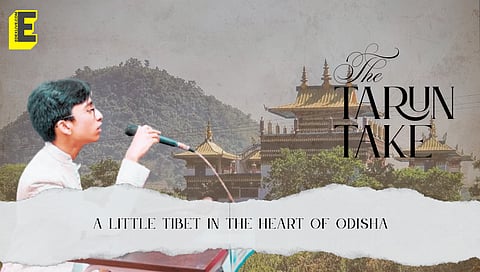

I started my 116-kilometre journey from Berhampur, past the verdant embrace of the untouched sal jungles beyond the Taptapani hot spring.
It was a pocket untucked behind the dense green, blanketed mountains. Tucked away in the gentle folds of the Eastern Ghats, amidst rolling maize fields and soft whispers of mountain breezes, lies a place that feels almost mythical in its contrast to its surroundings.
This is Phuntsokling—“Land of Happiness and Plenty”—a Tibetan settlement in the Gajapati district of southern Odisha. You may know it by other names: Jirang, Jirango, the Chandragiri Tibetan Settlement, or perhaps simply “Odisha’s Little Tibet.” Call it what you will, but one thing is certain—this place will quietly capture a piece of your heart.
When China invaded Tibet in 1959, thousands of Tibetans were forced to flee their homeland in search of safety and dignity. India opened its doors, and six settlements were established across the country for these exiles to begin life anew.
Chandragiri was one of them, designated as Camp No. 4. On May 1st, 1963, the first batch of Tibetan refugees arrived here, in what was then a remote and largely forested stretch of Odisha.
Today, more than sixty years later, what they have built here is not merely a settlement—it’s a vibrant, breathing cultural ecosystem that gracefully melds the serene philosophies of Tibetan Buddhism with the rugged beauty of the Indian subcontinent.
The Tibetans have turned this patch of land, comprising the villages of Labarasingh, Mahendragadh, Tankilipadar, Chandragiri, and Jirang, into a harmonious extension of the home they lost.
The maize fields that now stretch across the valley not only sustain their economy but have earned the region the title of “Maize Bowl of Odisha.”
Driving in from the highway, the road to Jirang soon sheds its asphalt confidence and takes on the dusty, earthy charm of a rural Indian detour. On both sides, farmlands ripple in the breeze, occasionally giving way to grazing livestock or sleepy clusters of homes.
The imposing backdrop of the Eastern Ghats soon begins to assert itself, with the mighty Mahendragiri peak—a mere 70 kilometres away—silently looming.
And then, like a scene lifted from a different world altogether, the golden vimana of the Padmasambhava Monastery glints in the distance. Known also as the Jirang Monastery, it is the largest monastery in Eastern India.
Inaugurated in 2010 by His Holiness the 14th Dalai Lama, the structure stands tall — not just in height, but in spiritual significance.
As we approached, the monastery’s white base rose like a lotus from the valley floor, with tiers of blue and gold accentuating its grandeur.
Near its entrance is a serene lake, with a statue of Guru Padmasambhava seated atop a lotus in its centre. The scene is almost too poetic—the calm waters, the backdrop of green hills, and the monastery reflected in its depths. For a moment, it feels like time is in no rush here.
Inside the monastery, the air carries a faint scent of incense, and the ambience is wrapped in a contemplative quiet. The 23-foot bronze statue of Lord Buddha in the meditation hall commands reverence, flanked by 17-foot effigies of Avalokitesvara and Padmasambhava. Golden-hued murals cover the walls, telling stories of Buddha, the cosmos, and the interconnectedness of all beings. Mandalas, dragons, phoenixes, lotus motifs — they all speak of a spiritual tradition both ancient and alive.
On one of the verandas, I noticed a few woolly dogs lounging lazily, clearly at home. Above us, prayer flags fluttered in the wind, their colours fading gently with time, but still carrying the same blessings written on them.
Across the five villages of the settlement, you’ll find smaller monasteries, prayer wheels, stupas, and statues — each a quiet testament to a people determined to keep their culture alive in exile.
At Mahendragadh, the Avalokitesvara statue sits in contemplative elegance, while Labarasingh’s smaller monastery echoes the same aesthetics as its grand sibling in Jirang.
The people here are warm, their smiles often soft and reserved. Outside the Jirang Monastery, we met a Tibetan woman in her mid-forties running a food court. Her Hindi was impeccable.
Indeed, they are as much a part of Odisha as the forests and hills that surround them.
Their presence has added a remarkable hue to the region’s cultural tapestry. Not just through architecture and art, but through the rhythms of daily life — monks studying scriptures, maize being harvested, prayer wheels spinning, and young novices walking to class in maroon robes.
This Tibetan settlement is not a tourist trap. It doesn’t shout for attention. It simply exists — quietly, peacefully, beautifully. It is a gentle reminder that identity can survive displacement, that culture can bloom even in exile, and that harmony is possible when roots grow deep, even in unfamiliar soil.
So, the next time you think of Odisha, think beyond its coasts, temples, and classical dance.
Think of a quiet valley where the past and present hold hands, where the prayer flags dance against a blue sky, and where the air hums with stories whispered by the hills.
In the heart of this unassuming coastal state lies a little pocket of Tibet. And it is nothing short of fascinating.
